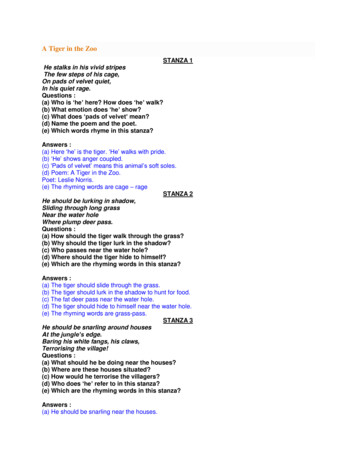
Transcription
LEGENDOFTHEWHITETIGER, 1 6 7 5 8 & 7 , 2 1 / . ( 7 2 % / & . % ( /7I N S T R U C T I O N A L K E Y TO B L A C K B E LT
First Edition. November 7, 1995Second Edition. August 15, 1998Third Edition. June, 2000Fourth Edition. June, 2004Fifth Edition. November, 2004Sixth Edition. November, 2013Seventh Edition. June, 2015Eighth Edition. August, 2016Ninth Edition. March, 2017White Tiger Taekwondo Inc. retains all rights, including copyright, trademarks, patents, and other proprietarymaterials whether embodied in written materials, computer storage, media, or otherwise. This publication containsproprietary information belonging to White Tiger Taekwondo. This information may not be used in any waywithout written authorization from White Tiger Taekwondo.Written and produced in Seoul, Korea. First printing in Korea. Second printing in the United States of America.Third Printing in the United States of America. No part of this publication may be reproduced, stored in a retrievalsystem, or transmitted, in any form or by any means, whether electronic, mechanical, photocopy, or otherwise,without prior written permission of White Tiger Taekwondo.White Tiger Taekwondo.Yong In Gun, Kyunggi do, Yong In Eup, U Bang Ri, 6/20137-0841U.S.A.1605 NW Maynard RoadCary, North Carolina 27513 White Tiger Taekwondo 2000 White Tiger Taekwondo 2004919-469-3553
ENDORSED BYTHE WORLD TAEKWONDO FEDERATIONSEOUL, KOREAiii
INTRODUCTIONTABLE OF CONTENTSEndorsed by Kukkiwon . . . . . . . . . . . . . . . . . . . . . . . . . . . . . . . . . . . . .iiiWhite Tiger Poem . . . . . . . . . . . . . . . . . . . . . . . . . . . . . . . . . . . . . . . . .viiWhite Tiger Mission . . . . . . . . . . . . . . . . . . . . . . . . . . . . . . . . . . . . . . .ixWelcome to New Students . . . . . . . . . . . . . . . . . . . . . . . . . . . . . . . . .1Login System . . . . . . . . . . . . . . . . . . . . . . . . . . . . . . . . . . . . . . . . . . . .2What every new Student and Parent should know . . . . . . . .2 & 3Doe-jahng rules and regulations . . . . . . . . . . . . . . . . . . . . . . . . . . . . .5Why bare feet? Why Key-hahp? . . . . . . . . . . . . . . . . . . . . . . . . . . . . .6Benefits of Martial Arts . . . . . . . . . . . . . . . . . . . . . . . . . . . . . . . .7 & 8Martial Arts Etiquette . . . . . . . . . . . . . . . . . . . . . . . . . . . . . . . . . . . . .9Doe-Jahng Etiquette . . . . . . . . . . . . . . . . . . . . . . . . . . . . . . . . . . . . . .10Taekwondo Doe-boke - uniform . . . . . . . . . . . . . . . . . . . . . . . . . . . .11How to care for the uniform . . . . . . . . . . . . . . . . . . . . . . . . . . . . . .12Free Chin-goo Uniform . . . . . . . . . . . . . . . . . . . . . . . . . . . . . . . . . . . .13How to care for the Dee - Belt . . . . . . . . . . . . . . . . . . . . . . . . . . . . .14How to tie your Belt & fold the Uniform . . . . . . . . . . . . . . . . . . . .15Class Procedure . . . . . . . . . . . . . . . . . . . . . . . . . . . . . . . . . . . . . . . . .16Message to Beginners . . . . . . . . . . . . . . . . . . . . . . . . . . . . . . . . . . . .17Beginner Do’s & Don’ts & Safety . . . . . . . . . . . . . . . . . . . . . . . . . .18The Key to your Success.is in your hands . . . . . . . . . . . . .19 & 20Commitment to Training . . . . . . . . . . . . . . . . . . . . . . . . . . . . . . . . .21Dispelling Martial Arts Myths . . . . . . . . . . . . . . . . . . . . . . . . . . . . .223 Areas of Martial Arts Focus . . . . . . . . . . . . . . . . . . . . . . . . . . . . .23Which Classes are best for me? . . . . . . . . . . . . . . . . . . . . . . . . . . . .24White Tiger Goals for Rank (chart) . . . . . . . . . . . . . . . . . . . . . . . . .25Tips to keep Children Motivated . . . . . . . . . . . . . . . . . . . . . . . . . . .26The Big Picture - Road to Black Belt . . . . . . . . . . . . . . . . . . . . . . . .27Rank Milestones . . . . . . . . . . . . . . . . . . . . . . . . . . . . . . . . . . . .28 & 29Professional Associations . . . . . . . . . . . . . . . . . . . . . . . . . . . . . . . . .30Association Patch Symbols . . . . . . . . . . . . . . . . . . . . . . . . . . . . . . . .31National Flags . . . . . . . . . . . . . . . . . . . . . . . . . . . . . . . . . . . . . . . . . . .32Policies & Procedures . . . . . . . . . . . . . . . . . . . . . . . . . . . . . . . . . . . .33
vi
If there is virtue in the spirit,Then there will be honor in the characterIf there is honor in the character,Then there will be respect in the homeIf there is respect in the home,Then there will be harmony in the nationIf there is harmony in the nation,Then there will be peace on Earth.-White Tigervii
viii
WHITE TIGER MISSIONOUR MISSION:To provide Olympicquality instructionfor the onlyactivity in theworld in which allparticipantsbenefit physically,mentally andphilosophically.TAEKWONDOANCIENT ART FORM MODERN OLYMPICSPORTix
WELCOME TO NEW STUDENTSDear Students and Parents,Taekwondo has been animportant part of my life fordecades. Now, you too havechosen a path in which thebenefits to your life will beimmeasurable.The disciplines of MartialArts are designed to makestudents non-violent, toinspire them with feelings ofconfidence, well-being andto make their life moremeaningful. The study ofMartial Arts, whileinstilling the student withmental, physical and spiritual balance, enables them toenjoy the benefits of societywithout being absorbed oroverwhelmed by it.We want your training to beuseful and rewarding. Thisbook will give a basicunderstanding of the stepsto your training.I welcome you to ourMartial Arts family.1Master Rondy
TIGER TIPEvery student is assigned an ID number. Thisnumber reflects the order in which you joined,and your place in White Tiger history. Use thisnumber to log into your account and class. Thelower the number, the higher the rank.Every White Tiger studentwill receive an ID Numberupon registration. The officewill take your photo foryour account. You mayupdate this photo when youlog into your account.Your ID Number will neverchange. If you add morestyles to your membership,the styles will separated inthe system - but will alwaysuse the same number.Write your name on theinside of your uniform so itwon’t be forgotten. Uponentering class: Make sure you use theID NUMBER & LOG INcorrect tablet for the roomyou are attending Simply key in your number and select “enter”. Ifyou have multiple styles,you will be promoted toselect which style you areattending at that time. Your name, photo, rankand any attendancemedals will show up onthe screen. You are nowready to enter the mat. If the file that appears isnot you - or you accidently key in the wrongnumber, see the officeASAP. They can help youlog in and receive creditfor the class. Be sure to log in for everyclass you take. Failure tolog in will result in younot earning credit for theclass. Class credits areimportant for earningawards and fulfillingthe requirements for rankpromotion.TIGER TIPWrite your number on theinside of your uniform incase you forget.2
WHAT EVERY NEW STUDENT AND PARENTinstructorsThe owner’s name is Master Rondy. Other instructors names are listed on the walls and flipcharts. You should address all Black Belts as "Sir" or by their last name; Mr. or Ms. .You may also call Masters by the Korean title Sa-bum-nim. Master Rondy, or the seniormaster, may also be called Kwan-jahng-nim. Female masters often use their first names, whilemale masters always use their last name. (Master Rondy is called Sifu Rondy in Wing Chun).event informationAll information: schedule changes, closings, testings, demonstrations, new classes, specials,contests or parties etc. is made available to you in multiple medias. All information isprovided to you weeks and even months in advance, the back of the class schedule has anevents schedule for the entire year. Parents, if your child is too young to read and properlyrelay the information to you, you will need to check for yourself.TIGER TIP QR CODES Tiger Times Newsletter: on our website, Facebook, email Schedule of classes, color coded per level: schedule rackDownload an app so you can readQR code from your phone. Back of Schedule, lists events for entire year: schedule rackhttps://itunes.apple.com/us Instructor messages, announced at end of classes/app/qr-code-reader-and Tiger TV video: plays in front entry, cafescanner/id388175979?mt 8 Facebook page: www.facebook.com/WhiteTigerTKD Pawcast, radio show of the week’s events: plays in the locker rooms, website “This week at White Tiger”: email message sent every week (make sure to provide correct address) Table Tents: on cafe tables Website, www.WhiteTigerTKD.com LED Flashing Lights: cafeuniform & belt informationDon't be shy to ask anyone with a higher belt to help you. They were once white belts.In time, new white belt students will be asking you to help them.Taekwondo uniform: the elastic stretches across your front to the other side and hooksaround the button, put the elastic under the front of the uniform.Hapkido uniform: women should put the right side over the left, men put the left side overthe right and tie the strings together on each side.Men do not need to wear anything under the uniform top,women need to wear a white t-shirt or sports top under the top.(Black Belt women may wear a black garment).NEVER wash the belt, it is a symbol of your learned knowledgeof Martial Arts. Never let your belt touch the ground. Don't hangit around your neck. If you forget your belt at class time, youwill be a "no belt" for the day. Line up in rank after the white orlowest rank belts.The belts start with the lowest level, 10th Gup, or white belt. Thenext level belt is "9th Gup" which is a white belt with a yellowstripe. Some schools have additional belts like orange, purpleand brown, but the colors shown on our wall are the only beltcolors accepted by the World Taekwondo Federation (OlympicStyle). For tournament purposes, belts are grouped together byGup number.TIGER TIPThe Korean terms used inthis book are italicized.The Korean language hasconsonants and vowelsthat we do not have ordo not sound exactly thesame in English. Theterms in this book arespelled phonetically,sound them out how theyare spelled.Different books may spellthe same word differently. The spellings in thisbook are by an AmericanEnglish speaker.rules & reGulationsTake time to read the rules and regulations of the school on the following pages,you are responsible for following them. They are also displayed outside the locker room.shoesStudents must take off their shoes and socks and place them in the belt-color shoe racks near3 the mat area. Do not walk on the mat unless you are in uniform.
OF A NEW STUDENT SHOULD KNOW.The only shoes allowed on the mat are Taekwondo shoes, do not use them for training(you can't pivot well and will injure your ankles). Leadership Teams may wear them forteaching. Do not wear Taekwondo shoes on the mat if you have just walked in from outside,try to keep the mat as clean as possible.terminoloGyWe use the Korean terms for many of the techniques in class. The Korean terms are used sinceTaekwondo and Hapkido originated in Korea. You will need to learn the terminology toadvance in rank. You will also need to learn the terms if you plan to compete in tournaments,Taekwondo referees are trained to use only Korean. Most of this terminology you will learnfrom hearing it everyday. You may also refer to the terminology section in this manual. Theterminology is spelled out phonetically, so pronounce it how it looks. The Korean wordsthroughout this manual are displayed in italics and are hyphenated to show syllables. Phoneticspellings for the same word may vary from source to source. Student Manual Study Class onFriday nights will also teach the terminology. Visual and audio flash cards are available.testinGBeginners start with a white belt. to get to the next belt level of yellow stripe, 9th Gup, youmust earn another two black stripes and a white stripe. You will then be invited to formal testing to perform the requirements before the testing board. There is a fee for this certified testing.The amount is proportionate with increasing rank, but testings are spaced further apart. Testingrequirements for each belt are located in this manual. To test, students (school age) must presentcopies of school report cards, a home report card that has been graded by a parent or guardianand a letter of recommendation. Testing is optional. Results from testing are announced a fewdays after testing at the end of class, private tests may take up to a week. if you plan to test,your application must be turned in the thursday prior to testing day or before.The Tiger Tot class follows the same curriculum but is broken down into steps. Tots test to earndifferent colored Sashes during regular testing times. Check the manual chart, attendance cardor poster near the classroom for Tiger Tot testing requirements.Testing is designed to build confidence, not tear it down. This is why we test by prequalification only. Always strive to do your best. As beginners, you may become nervous, and may notperform as well as you do in class. In extreme cases of stage fright, your instructors wouldhave you show them the techniques again the following week before or after class, or at thenext test. They will work with you until you do pass. As your rank increases, you will becomeless and less nervous.other equipmentBefore you test, you must earn the 4 patches; school, association, American and Korean flags,and have them sewn on your uniform. A sewing service is available, see the office.You must have a yellow stripe belt to begin sparring. You must have full safety equipment tobegin sparring, 145- 165. for insurance purposes, only White tiger gear is allowed.tournamentsTournaments are optional. Never compete in a tournament unless your instructor is present. Youshould always have a coach. If you wish to attend a tournament and it has not been posted,bring it to your Master's attention - may wish to attend as a school. Tournaments can cost from 50 to 75 and this fee is paid to the organization hosting the tournament, not to White Tiger.Throughout the year, White Tiger hosts internal tournaments. These are low cost practice tournaments with trophies or medals and ideal for a first time competitor. White Tiger also hosts aHoliday Tournament in December complete with medals. This Tournament is a free tournamentfor all White Tiger students.outside tournament info: https://www.facebook.com/whitetigermasters?ref br rs4
DOE-JAHNG RULES AND REGULATIONSTraining in Martial Arts is mental as well as physical in nature. In addition to techniquesof self-defense, we are learning an art which builds self-control, discipline and respect forother people. These mental states are attained by following of certain traditions and formalbehavior while within the doe-jahng.1. Respect and obey your instructors and higher ranking belts at all times.2. Always bow:a. upon entering and leaving the doe-jahng.b. upon entering and leaving the mat area.c. when first seeing the senior instructors, and once again when leaving for the day.d. when beginning and ending practice with a partner.e. before and after asking the instructor for assistance or advice.3. Be in full uniform and on the stretch mat at least five minutes before class starts.4. Take off your shoes and store them on the appropriate color shoe rack by the mat.5. Keep all uniforms clean at all times. Also, pay respect to your own body and keep yourself clean and well groomed.6. Keep your fingernails and toenails trimmed short.7. No watches, rings, or jewelry of any sort will be worn during training, except eyeglasseswhen necessary. This includes removing wedding rings.8. No smoking, drinking water or soft drinks, chewing gum, loud talking, laughing orhorse play in class. The instructor will let you know when it is time for water breaks.9. No unnecessary noise. When not participating, please sit or stretch quietly: rememberthat by watching others practice, you will also learn.10. No slouching, reclining, sitting or leaning against the wall is allowed in class.11. Do not sit on the gymnastics mats or touch the mirrors. No weapons near mirrors.12. Do not use profanity.13. You should refer to higher ranking belts as Mr. or Ms. , no matter what their age.14. The Senior Master Instructor of your school is always to addressed by their propertitle, "Sir", or Kwan-jahng-nim. Senior instructors are called, "Sir", or Sa-bum-nim.15. In reply to a question or command requiring an answer, all students should answer"Yes, Sir" or "No, Sir".16. Go to Leadership Team members with problem or with questions that need to beanswered before you see your instructor.17. Memorize the names of the Taekwondo movements in Korean.18. The doe-jahng will be kept neat and clean by its members.19. Never do anything to dishonor our school or your instructor.20. Never willingly fight, for any reason.21. Parents: Encourage your children! Their efforts need to berewarded. Do not compare them with others in theclass. Each child is unique, and will benefit differentlyfrom the next. Parents and visitors are welcome to watch classanytime, however, we ask that you do not talk to your childduring class time. Please leave the discipline and coaching to us.22. No concealed weapons or anything that may harm others.523. Endeavor to develop yourself mentally and physically in the Martial Artsspirit and to keep friendship with other members.
WHY BARE FEET? WHY KEY-HAHP?Why Do martial arts stuDents taKe off their shoesbefore traininG?There are five general reason why Martial Arts students take off their shoes before theyenter the doe-jahng.1. To create "natural" body balance and coordination.2. Ancient Oriental Custom. It is said that the shoes bring in thetroubles of the street. When visiting a friend in the Orient, onedoes not bring him the troubles of the street or one's own personalproblems, but to visit another's home means to pay him and hisfamily respect and to hear what he may have to say.3. Prevention of injury from the hard leather shoe while sparringwith a fellow student.4. A method to keep the training area clean from pebbles and dirtfrom the street.TIGERTRIVIAIn Korea, youmust removeyour shoesbefore enteringa person's home.Restaurants willprovide you withslippers to wearafter you removeyour shoes andleave them bythe door.5. A method to strengthen and condition the feet and ankles.Place your shoes in thecorresponding colorcubbie to your rank.Why Do martial arts stuDents yell?The yell, or key-hahp, plays a very important part in formal Martial Arts training. If the key-hahpis executed properly, the yell comes from the pit of the stomach, not the throat. The key-hahp,when applied properly, will result in the following:1. You will obtain more power (breathing control).2. You may possibly startle or intimidate your opponent.3. You many cause an attacker to hesitate, creating your chance to react.4. You will reduce the tension in your own body.5. You will decrease your own awareness of pain.6. Repetitive key-hahps will condition the abdominal muscles, thus allowing them toabsorb a harder blow.7. While absorbing a blow or while falling, such as nok-bup techniques, the key-hahp forcesthe air out of the lungs. This prevents the air from being forced out (ie. have your windknocked out) leaving you temporarily disabled.8. In practice such as one-step sparring, the key-hahp is used as a signal to indicate to yourpartner that you are ready.9. The key-hahp helps to regulate controlled breathing which aides in increasing stamina.6
BENEFITS OF MARTIAL ARTSMartial Arts will teach youhow to protect yourself inthe event of physicalconfrontation, but this is themost modest of their benefits. In addition to helpingyou get and stay physicallyfit, Martial Arts can help youminimize stress, develop better focus and self-discipline,and move you along theroad to self-discovery.In each Martial Arts class,you'll learn how to harnessyour natural strength. Notjust the muscular variety, butthe power that lies in yourspirit and mind.beyondTIGER TIPthe walls Some students havebeen able to discontinof theue medication for ADDand even depressionMartialafter a few monthsArtsof training.school.Many parents,doctors,teachers andpsychologists findthat Martial Artsimprove children'sacademic progress –attention span, listeningskills, cooperative learning,following directions andleadership skills are all areasof training that directlycarry over to the academicclassroom.essential physical, motor,linguistic, perceptual andsocial skills. Children asyoung as three years ofage learn fundamental movementsthat can improvetheir sense of balanceand coordination.As boys and girlsadvance throughtheir training, they'll beintroduced to more complex drills that will challenge and improve theirability to concentrate,which in turn can elevatetheir self-esteem.teensAs childhood slips away,youngsters enter a stagewhere they becomeincreasingly independentof their parents. Theirphysical growth is readily apparent but theirintellectual and emotional development cannot PFUNchilDrenChildren's classes aredivided by both age and skilllevel. All children are taughtat their own pace to developtheir present capabilities andbring out their hiddenpotential. The Masters arecommitted to helping eachand every student improve.The goal of the White Tigerchildren's program is to pro7 vide benefits that extendGENTLENESSAs a society, we are becoming better educated aboutthe needs of children whosuffer from ADD (AttentionDeficit Disorder) and ODD(Oppositional DefiantDisorder), not to mentionpeer pressure andalienation. A well-roundedMartial Arts curriculum canhelp your child cope withthese problems and GRADESINCREASEENERGYINDOMITABLESPIRIT
ITUDEPRIDEQUALITY IONSTRENGTHTEMPERCONTROLTONE & FIRMTRUSTVITALITYWISDOMBENEFITS OF MARTIAL ARTSas easily measured.Lines of communicationcan become crossed,tangled, strained and, insome cases, completelydisconnected. Unlikeorganized team sports,which often fail tonurture the individual,Martial Arts canprovide your son ordaughter with thechance to becomestronger and moreflexible and to improvetheir overall health andself-image. They'll cometo recognize the rewardsof hard work and discipline, which often leadto improved academicperformance. They'llmake friends who sharea healthy interest andthey'll fortify themselves against negativepeer pressure.Youngsters who havebeen taught to respecttheir bodies andminds are less likelyto fall prey to usinglife-endangering substances or engaging inactivities that candestroy their health.aDultsWhite Tiger offersadults a comprehensive fitness program.Classes are specifically designed toincrease cardiovascular capacity, muscularstrength, endurance andflexibility. They can providean opportunity for weightloss and stress relief. Inaddition, training in MartialArts produces benefitsbeyond those of a traditionalexercise program.Martial Arts training isexercise with a purpose.While youimprove yourphysical fitness,you will also bedevelopingimportant selfdefense skills.You will learn toconfront andcombat yourfears. The confidence you gainfrom learningself-defense,improving yourfitness, and feeling better aboutyourself willhelp you copewith daily situations at homeand work.If you are concerned aboutyour ability to stick with anexercise program, MartialArts is the choice for you.The variety of Martial Artstechniques will provide aconstant challenge, and therank system will showyour progress and keepyou motivated.familiesToday many parents arelooking for activities thatallow the entire family tospend time together. Parentsand children can traintogether effectively inMartial Arts because everyone starts as a beginner.Doing Martial Arts togetheras a family allows you towork hard together in orderto improve physical fitness,self confidence, anddiscipline while havingfun at the same time!8
MARTIAL ARTS ETIQUETTERESPECTFUL BOWWhy boW?The bow is to reflect respectfrom one's soul. It can beconsidered the ultimatesymbol in showing respectthat would be difficult toexplain in words. Unlike theAmerican handshake, whichis sometimes taken forgranted, this ancient customdates back to the beginningof time, when one man firstapproached another man infriendship and wanted toshow respect for oneanother's presence. When aMartial Art student bows tohis instructor, he is showingrespect and recognition ofthe instructor's higherauthority in the art. Whenone student bows toanother, he is showingrespect, friendship and trust.When students bow to theAmerican flag at thebeginning and end of class,they are saluting the flagand honoring what itrepresents. If the Koreanflag is on display, they showtheir respect by bowing to itin recognition of the fact thatKorea is the mother country9 of Taekwondo.TIGER TIPIn Korea they say it is themature rice stalk that bows itsfull head. It is the hollow stalkwith an empty head that standsup straight defying a bow.looking straight into hisopponent's face while bowis made at about a thirtydegree angle, then back tothe attention position.This type of bow is usedprimarily for competingin tournaments.respectful boW:The student comes to attention with cupped hands athis sides. The empty handsindicate that he has noweapon. The bow is thenmade at least at a forty-fivedegree angle, with the facelooking at the floor, thenslowly back upward toattention. Note: This bowdemonstrates total trust,revealing the back of theneck, a very vulnerable area.challenGinG boW:The student comes to attention with clenched fists atsides, the fists as weapons,Note: It would considereddisrespectful to use thechallenging bow whenaddressing your instructor,a black belt or higherranked student.respect to othersShowing respect to otherson or off the training floor ispart of being a student inMartial Arts. While training,one should show respect atall times including to one'sopponents. One shouldnever lose patience, it is asign of weakness. Maintainself-control and selfconfidence at all times.CHALLENGINGBOW
DOE-JAHNG ETIQUETTEsittinG in the doe-jahnGThere are only three ways that students are allowed to sit while wearing the training uniform, during class, at testings or special Martial Arts events. With the legs crossed, on the knees or with thearms wrapped around the knees. Students in uniform are never allowed to slouch, lean against thewall, lean on each other, sit on the gymnastics mats, sit on the counter or lay down. If they areattending an event and chairs are limited, they should always offer their chair to a parent, elder,senior or guest. Do your best to follow the rules and have the confidence to practice them often.etiquette1. GENERAL BOWING: When you bow, you must be in a position of attention with your head andupper body bent at 450 (the deeper the bow, the more respect you are showing), You must cometo a complete stop and bring the heels of your feet together vigorously.2. BOWING TO SENIOR BLACK BELT: When a senior Black Belt or Master Rondy enters theschool for the first time that day, the highest ranking student should yell "Cha-ryot". At thistime, no matter what you are doing, you should stop completely to face the senior and then thehighest ranking student should say "Kyung-nay". All students then say "Ahn-yong Ha-shim-neka?". If the highest ranking student fails to do this, the next in rank should take over.3. PRESENTATION OF DOCUMENTS: When handing papers or something with writing on itincluding an application or certificate, always turn the document so the other can read it. Bow,and use two hands to pass it. Always accept with two hands.4. PRESENTATION OF OBjECTS: When working with weapons or targets in class, always turnthem around to pass them to your partner, offering them the handle.5. CONVERSATION: Do not interrupt the conversations of others. Hands must not be placedinside pockets at any time while conversing with a senior.6. INTRODUCTIONS: When introducing people, always introduce the junior to the senior.7. ATTENDING TO SENIORS: When entering a room, the junior must enter first, then stand toone side and allow the senior to enter and lead the way.8. SITTING: Before sitting down, you must wait until your senior is seated comfortably.9. CEREMONY SEATING: The seating must be arranged so that the highest ranking is in thecenter, with the immediate lower ranking to the right and left and descending in rank.10. CLEANING THE SCHOOL: Help with keeping the school clean. If you witness a seniorcleaning the school, you should immediately take over the task.10
TAEKWONDO DOE-BOKE - UNIFORMThe doe-boke is considered a primary necessity in training for the following reasons: Wearing the doe-boke should instill pride in the wearer as a practitioner of Taekwondo. It identifies individual capacity and degree of Taekwondo cultural education attained. The style of the doe-boke is symbolic of Taekwondo's heritage and tradition. Rank changes create incentives while at the same time preserve humility. It is practical and comfortable for training.It is very important for thewearer to keep the doe-bokeclean and wrinkle free at alltimes (do not wash the belt).Wear it correctly, and treat itwith the respect owed tothis art. When in doe-boke,remove all jewel
White Tiger Taekwondo Inc. retains all rights, including copyright, trademarks, patents, and other proprietary materials whether embodied in written materials, computer storage, media, or otherwise. This publication contains proprietary information belonging to White Tiger Taekwondo. This information may not be used in any way










